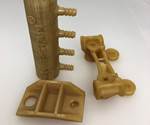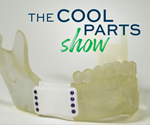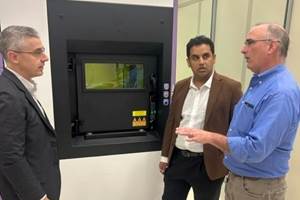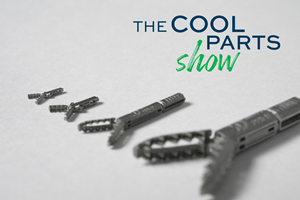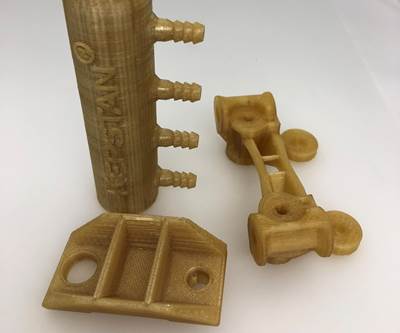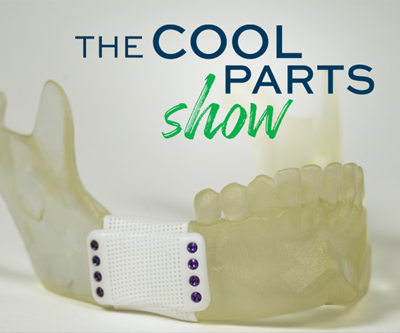Suture anchors are fasteners used to join soft tissue to bone in surgeries. Typically these devices are made from machined titanium, which offers corrosion resistance and biocompatibility but is costly. Oxford Performance Materials (OPM), a specialist in producing and manufacturing with polyether ketone ketone (PEKK), is 3D printing suture anchors from this thermoplastic. Using selective laser sintering (SLS), OPM can produce large batches of suture anchors in a variety of sizes simultaneously and at reduced cost compared to conventional titanium. But the PEKK material offers other valuable advantages as well — at least one of which was entirely unexpected. | This episode of The Cool Parts Show brought to you by Carpenter Additive
The Cool Parts Show is a video series from Additive Manufacturing Media that explores the what, how and why of unusual 3D printed parts. Watch more here.
Have a cool part to share? Email us.
Related Resources
- Research on the bacteria inhibition properties of PEKK
- Another episode highlighting implants made from an unusual material (in this case, bioceramics)
- More on 3D printing with PEKK and similar semicrystalline polymers
Transcript
00:00:00:05 - 00:00:00:17
Pete Zelinski
I'm Pete.
00:00:01:01 - 00:00:05:20
Stephanie Hendrixson
I'm Stephanie. And this is The Cool Parts Show, our show all about innovative, unique 3D printed parts.
00:00:06:06 - 00:00:15:15
Pete Zelinski
On this episode of the show, we're going to talk about these suture anchors which promise to make surgeries both more affordable and more likely to succeed.
00:00:15:23 - 00:00:33:09
Stephanie Hendrixson
The reason why comes down to the material. 3D printed medical implants made from polyetherketoneketone or PEKK on this episode of The Cool Parts Show. This episode of The Cool Parts Show is brought to you by Carpenter Additive.
00:00:33:09 - 00:00:36:17
Pete Zelinski
We're at the company's powder production facility in Athens, Alabama.
00:00:36:19 - 00:00:42:19
Stephanie Hendrixson
Specifically, we are standing on top of the Z1, the company's largest vacuum atomizer for producing metal powders.
00:00:43:01 - 00:00:49:15
Pete Zelinski
Want to know how to make metal powder for additive manufacturing? Stick around after the episode. Welcome to The Cool Parts Show.
00:00:49:22 - 00:01:04:23
Stephanie Hendrixson
Thanks for joining us. And if you like what you see, subscribe to the channel and hit that bell icon to get notified about new episodes. Today on the show, we're going to be talking about these little implants. These are suture anchors. And as we said in the cold open, they're made from a thermoplastic polymer called polyetherketoneketone. Often abbreviated as P. E. K. K. or PEKK (peck).
00:01:08:13 - 00:01:26:11
Pete Zelinski
So, yeah, suture anchors. This is a sophisticated implant. But what it does is pretty straightforward. It connects soft tissue to bone in surgery. This is a fastener for putting injured patients back together. And it's usually made of metal.
00:01:27:02 - 00:01:52:09
Stephanie Hendrixson
Yeah. There are a couple of different materials and ways that these are produced, but they're typically machined titanium. Titanium is good for this application because it's lightweight, it's strong, it resists corrosion. It has a long history of being used in the body, but it can also have some challenges. Titanium is more stiff than our bone, and so it can cause something called stress shielding, which is where the stronger implant sort of takes the impact. You can't see through a titanium implant on an X-ray. It might not integrate as fully with the bone. And if you need to make a repair later, it might be difficult to remove that titanium implant. But maybe its biggest challenge is cost. A machined titanium suture anchor tends to be expensive.
00:02:08:12 - 00:02:37:10
Pete Zelinski
So you said expensive. That's significant. So 3D printing of PEKK allows for suture anchors that are both more affordable and better performing. And we're going to unpack both of those areas of improvement. But first, suture anchors. Let's learn a little bit more about what they are, what they do. Here is orthopedic surgeon Dr. Bryan Hanypsiak, who specializes in particular in surgeries of the knee and shoulder.
00:02:38:06 - 00:03:08:18
Dr. Bryan Hanypsiak
Well, a suture anchor is one of the many tools we have in sports medicine for repairing soft tissue to bone. I tell my patients a suture anchor is very similar to a drywall anchor. Same concept is true for a suture anchor. It goes into the bone. And the bone actually has two parts. It has an outer cortical shell, which is a very hard bone, and then it has an inner medullary component, which is a softer bone marrow type bone.
And so the suture anchor will typically go through the cortex into the medullary bone. And most of them are designed to either deploy beneath the cortex so they can't be pulled back out or to engage the cortex with the screw pitch so that it's very difficult to pull those back out. So they're really just devices that we use for reattaching tissue back to bone.
One of the more proven concepts in orthopedic surgery states that the strength of the repair is most reliant on the number of sutures crossing the repair site. And doing that, we will typically put more suture anchors with more suture threads across a repair. So example, if you looked at a repair of a tendon, the more anchors that could be fit into the bone with the more sutures passed through the tendon and then tied down or locked into place, the stronger that repair will be on pull out testing.
00:04:13:05 - 00:04:33:18
Stephanie Hendrixson
So we won't get into specific dollar amounts. But to give you some idea of the cost savings, one of these 3D printed PEKK suture anchors could be just about 10% the cost of a conventional one. So if more anchors means a stronger repair, making them more affordable means that surgeons can be maybe a little bit more free to use them everywhere that they're needed and lead to better patient outcomes.
Let's talk a little bit about how these were made. So these suture anchors are produced by a company called Oxford Performance Materials, or OPM. They are a specialist in this PEKK material. They make the material, they use it in lots of different ways. They machine it, they mold it. But as we've said, these suture anchors are 3D printed. For that they use a selective laser sintering process or SLS, it's a powder based process. You're using a laser to melt the powder PEKK material to build up these implants. And I want to introduce Scott DeFelice. He is the founder and CEO of OPM. He can talk more about how they use this technology.
00:05:07:11 - 00:05:33:00
Scott DeFelice
The printing is done in-house. We use EOS machines that we've subsequently modified for the purpose of our high temperature process. A powder bed melting process is really a pretty advantageous process and that allows you to get fully consolidated, fully dense parts with highly repeatable mechanical performance. There's a world in which people will say, Well, 3D printing is cool, but expensive.
Well, it just depends what you're doing, right? In our world, it's cool and less expensive. Typically, almost everything we're doing, we're changing the cost curve substantially and providing more clinical benefit.
00:05:48:15 - 00:06:12:22
Pete Zelinski
That last part is key. We're accustomed with 3D printing, with additive manufacturing, to there being this tradeoff. Like you can have your cool part, you can have any part you want, but it's expensive. Yet here's a case where 3D printing offered the lower cost option, so that opened the way to using PEKK as the material for these anchors and that's really valuable. And let's go there. Let's talk about the benefits of PEKK for suture anchors.
00:06:19:10 - 00:06:41:13
Stephanie Hendrixson
Yes. So the material characteristics of PEKK just have a lot of advantages for implants like this. The stiffness of this material is much more similar to our natural bone. And so that means you can avoid those issues with stress shielding that you might see with titanium implants. It has good osteo integration. So your body sees this as something it can grow bone into and will do that pretty readily. But as we learned from Scott, it also has this interesting property that I think nobody really anticipated.
00:06:48:11 - 00:07:14:15
Scott DeFelice
Sometimes it's just great to be lucky. And this is one of those situations where, you know, we found out kind of through happenstance it didn't seem that that bacteria were growing on the PEKK. And this just happened as a result of some routine bio burden testing in the company. We went up to Northeastern and we asked a researcher to take a look at it, a guy by the name of Dr. Thomas Webster, and he came back and said, You're right, there's something funny going on here. Bugs aren’t growing on your PEKK.
So like many implants that are used in orthopedic surgery, I tell my patients that metal and plastic tend to be like Disney World for bacteria because your body can't grow blood vessels through the metal and plastic to get to any bacteria.
00:07:16:10 - 00:07:40:00
Dr. Bryan Hanypsiak
For whatever reason, and no one's quite sure why bacteria will not deposit a biofilm on the anchor. So like many implants that are used in orthopedic surgery, I tell my patients that metal and plastic tend to be like Disney World for bacteria because your body can't grow blood vessels through the metal and plastic to get to any bacteria. We have to go in there and physically clean the bacteria off and they secrete a biofilm that covers themselves and prevent standard antibiotics or chemicals from getting in. And so we have to physically go in and scrub this biofilm off or at worst cases, remove the implants and replace them with fresh ones. These anchors, for whatever reason, and the same is true of PEEK, biofilm does not grow on the anchors. And so they're a bit more protected in the setting of a patient that's at risk for infection.
00:08:20:10 - 00:08:53:01
Pete Zelinski
Okay, so PEKK in suture anchors gives you all this great stuff. The material wants to stress and move in ways that are similar to the way human bone stresses and moves. And bone really wants to grow into this rough surface. Plus, bugs don't grow on it. It is demonstrably resistant to bacteria. All those benefits are there. And then the other part of the story is 3D printing allows these benefits to be realized in a cost effective way.
00:08:53:14 - 00:09:12:22
Stephanie Hendrixson
Yeah, and as you were saying earlier, like we're used to seeing this tradeoff, you go with 3D printing because it allows you to get the geometric benefits, the control over the material properties, maybe a lead time advantage, but it's typically not the cost effective option. Here they are realizing benefits from the material properties, from the design, but they're getting that cost savings as well. Scott has more to say about that.
00:09:14:18 - 00:09:38:05
Scott DeFelice
So it's the power of the technology, honestly, is where the cost savings come from. The manufacturing technology we practice gets very, very efficient, small, small parts. Something smaller than the size of a fist, you know, you're super economically efficient. Now, if you're making one part in a whole build, like a massive part for an aerospace component, you know, if that part doesn't work, you've got yield. It's kind of risky. But these small parts are super competitive. And, you know, we compete with mass produced, molded or mass produced machine parts every day.
00:09:49:07 - 00:10:13:08
Pete Zelinski
These suture anchors are 3D printed, selective laser sintering in a batch of about 600 at a time. The build takes about 12 hours. The parts are pretty much complete after 3D printing, and that build of 600 could be any combination of suture anchor designs. It doesn't have to be all the same part. So this opens up a couple of possibilities.
One of them is manufacture at the hospital. Don't wait to order and then ship and then store anchors like these, instead produce them as they're needed at the point of surgery. Another possibility hypothetically, design the suture anchor you need according to the needs of the patient, design the anchor on the fly according to the surgical requirements and individual patient needs.
00:10:41:17 - 00:11:11:07
Dr. Bryan Hanypsiak
I had a patient with Morquio syndrome who had substantial deformity to her bones and had a fracture, and there is just nothing that would go down the shape of that bone. If I had 3D printed technology to simply just scan her bone, feed the CT scan into the printer and manufacture a custom implant to be used directly for her, and it would fit her bone perfectly. So it allows for us to find solutions where with conventional materials, no solutions exist.
00:11:20:03 - 00:11:44:07
Stephanie Hendrixson
So these suture anchors have gone through the FDA approval process. They're being used in surgeries today. That is a win for doctors, a win for patients for all the reasons that we've been talking about. But these little anchors are doing something else. They're kind of serving as an ambassador part. Get surgeons used to the idea of a 3D printed PEKK suture anchor, get them using these devices, and it opens up the door to other types of devices made from this material.
So this is the way that you potentially get to that distributed manufacturing, making the implants right in the hospital, that you get surgeons thinking about this as a potential custom solution for other types of medical implants.
00:11:56:08 - 00:12:11:15
Pete Zelinski
Yeah, that's maybe the biggest benefit of these suture anchors is the acceptance and approval pathway that they're charting that eventually is going to be followed by all of these other potential surgical applications of 3D printed PEKK.
We have to completely de-risk everything.
00:12:11:15 - 00:12:37:10
Scott DeFelice
Believe it or not, the orthopedic companies are kind of conservative, right? We can't go to them and say, Hey, we got this great thing, it'll work great. Why don't you guys go develop it? They'll say, Come back when it's cleared and been used by the first 50 surgeons. We have to completely de-risk everything. But once it's de-risked, then we can go to them and they'll say, Yeah, we'll now develop our own implant with our own systems and our own instruments.
So the suture anchor that we launched was for that purpose, which was to get the regulatory clearance, get the first surgeons using it, and then ultimately go to the larger companies and say, okay, now we have proven this, let's go forward.
00:12:54:04 - 00:13:17:19
Stephanie Hendrixson
So lots of potential future applications for 3D printed PEKK As a result of these suture anchors. We should also say that OPM is doing a lot more with this PEKK material. They're making parts for other industries like oil and gas, like electric vehicles. They've also found a way to take advantage of PEKKs antibacterial properties and come up with a way to coat other parts in this so you can get that benefit without having to make the entire part out of this material.
00:13:18:13 - 00:13:35:23
Pete Zelinski
All right. I think we got this. These are suture anchors used in surgery to fasten tendon to bone. They are made of PEKK, and the benefits of that material are realized in parts thanks to cost effective production using 3D printing.
00:13:36:12 - 00:13:55:07
Stephanie Hendrixson
Polyetherketoneketone or PEKK is a thermoplastic that offers mechanical properties similar to human bone. It also provides for good osteo integration. So your bone wants to grow into it, leading to better healing outcomes. And as OPM discovered, PEKK has this antibacterial property as well. So it is a safer implant in that regard too.
00:13:55:19 - 00:14:14:21
Pete Zelinski
The suture anchors are made in a variety of sizes. They could be customized to the patient, could be manufactured at the hospital. They're being produced now, and their use, among other benefits, clears the way for other potential surgical applications of 3D printed PEKK.
00:14:15:10 - 00:14:27:18
Stephanie Hendrixson
All right, that's it for this episode of The Cool Parts Show. If you like the episode, you have a question? Let us know in the comments below and check out our back episodes. We have 60 episodes now. Lots of bonus content on our channel Additive Manufacturing Media.
00:14:28:03 - 00:14:36:20
Pete Zelinski
If you have an amazing breakthrough 3D printed part, we want to hear about it. CoolParts@AdditiveManufacturing.media.
00:14:37:06 - 00:14:47:17
Stephanie Hendrixson
And if you'd like to learn more about 3D printing technology and applications, check out our newsletter, The Build Up. You can subscribe to that at AdditiveManufacturing.media and we'll put a link in the show notes below. Thanks for watching.
00:14:48:13 - 00:15:10:09
Pete Zelinski
This episode is brought to you by Carpenter Additive. We are at the company's powder production facility in Athens, Alabama, and we are standing on top of an atomizer. The Z1 is Carpenter Technology's largest vacuum atomizer and it is the heart of the process for making additive manufacturing metal powder here at Carpenter Additive.
00:15:10:16 - 00:15:18:19
Stephanie Hendrixson
This facility is capable of producing up to 18,000 pounds of metal powder per day. Plant manager Jordan Ralph talked us through the process.
00:15:19:07 - 00:15:49:21
Jordan Ralph
So an atomizer is a piece of equipment that is capable of melting and pouring molten metal into the stream of high pressure gas that turns that molten metal into tiny, tiny droplets that ultimately cool and form our powder, which looks like a grey dust. So to start our process and the ultimate in the end solution that we have here, we bring in raw materials all the way down to individual elements.
00:15:49:21 - 00:16:22:02
Jordan Ralph
So nickel, cobalt, chrome, moli, niobium, we bring all of those raw materials into the shop. We utilize those materials to build charges that go into the atomizer. As you walk that flow path, you run through our charge make up area where all of the materials are weighed out in very exact quantities. That ensures that we're able to hit our customer specifications and hold the tight tolerances that we're looking for on a chemistry perspective.
00:16:23:05 - 00:16:49:15
Jordan Ralph
From there, the material is flown to the top of the atomizer and charged into the furnace as the materials produced it is poured out and is collected at the bottom of the atomizer. The material is then taken and transferred into a bulk container for processing through the rest of the value stream. The next stop for any of our atomized powder would be the screener.
00:16:50:14 - 00:17:17:05
Jordan Ralph
So that will remove the coarse portion of the powder. From there we take it through air classification. That takes the fine portion of the particle size distribution out and makes the final cut for an additive material like a 10 to 45. From there we stack up all of those individual lots and put them into the 12,000 pound blender to make the single homogenous blends.
00:17:18:06 - 00:18:01:20
Jordan Ralph
At that point we are able to pack in any configurations the customer's looking for, whether that be drums, bottles, PowderTrace hoppers. You know, we've got a lot of a lot of options to meet customers needs. The atomization, capability and all of the powder capabilities gives us a unique position where we're actually able to produce the powder, run testing through additive machines all the way through HIP and heat treat, do final testing on those products, and then make additional changes or try to optimize things like our chemistry or sizing so that we ultimately can serve our customers better.
Related Content
8 Cool Parts From Formnext 2023: The Cool Parts Show #65
New additive manufacturing technologies on display at Formnext were in many cases producing notable end-use components. Here are some of the coolest parts we found at this year’s show.
Read MoreCranial Implant 3D Printed From Hydroxyapatite Ceramic: The Cool Parts Show #76
Cranial implants are typically made from titanium or PEEK; in this episode of The Cool Parts Show, we look at how implants made from a bioceramic can improve osseointegration and healing.
Read MoreNew Zeda Additive Manufacturing Factory in Ohio Will Serve Medical, Military and Aerospace Production
Site providing laser powder bed fusion as well as machining and other postprocessing will open in late 2023, and will employ over 100. Chief technology officer Greg Morris sees economic and personnel advantages of serving different markets from a single AM facility.
Read MoreMicro Robot Gripper 3D Printed All at Once, No Assembly Required: The Cool Parts Show #59
Fine control over laser powder bed fusion achieves precise spacing between adjoining moving surfaces. The Cool Parts Show looks at micro 3D printing of metal for moving components made in one piece.
Read MoreRead Next
Ultem, PEEK or PEKK? Choosing Between High-Temperature Plastics
How do you choose between these high-performance materials? A conversation with Arkema and Plural AM sheds light on 3D printing with these polymers.
Read MoreBioceramics for Bone Replacement: The Cool Parts Show #18
A mandibular cage made up of two different bioresorbable ceramics points to the future of bone graft and reconstructive surgeries in this episode of The Cool Parts Show.
Read MorePostprocessing Steps and Costs for Metal 3D Printing
When your metal part is done 3D printing, you just pull it out of the machine and start using it, right? Not exactly.
Read More

.jpg;width=70;height=70;mode=crop)
